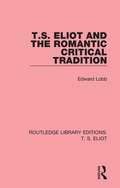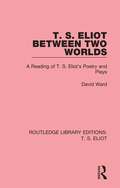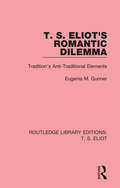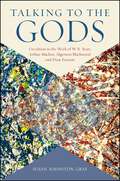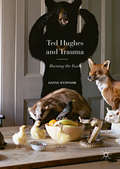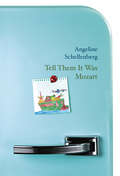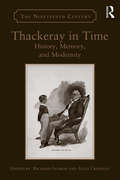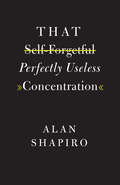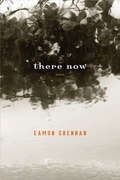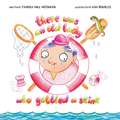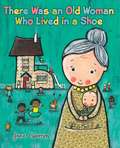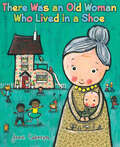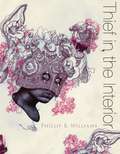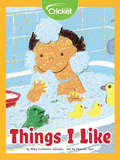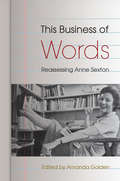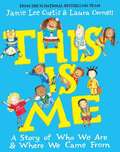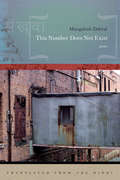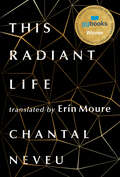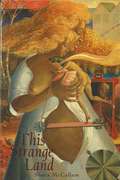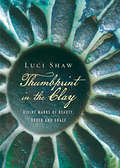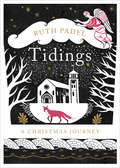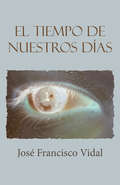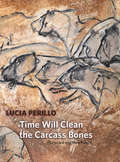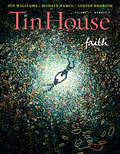- Table View
- List View
T. S. Eliot and the Romantic Critical Tradition (Routledge Library Editions: T. S. Eliot #5)
by Edward LobbEdward Lobb’s study, first published in 1981, is a thorough examination of Eliot’s relation to Romantic criticism. This title also makes extensive use of Eliot’s Clark Lectures on metaphysical poetry. Delivered in 1926, the lectures complete the picture of literary history set out in Eliot’s published work, and are, the author believes, essential to a full understanding of the poet’s ideas and their place in tradition. Drawing on a wide variety of primary sources and earlier scholarship, T. S. Eliot and the Romantic Critical Tradition will be of interest to students of literature.
T. S. Eliot Between Two Worlds: A Reading of T. S. Eliot's Poetry and Plays (Routledge Library Editions: T. S. Eliot #10)
by David WardThe basis of this critical examination of Eliot’s work, first published in 1973, is the investigation of his transmutation of this and other philosophical, mythological and religious motives into the textures of his verse. This book focuses on Eliot’s peculiar eclectic approach to what he described as ‘the Tradition’. It also recognises the fact that Eliot, for all his attempts at universality, was a product of time and place, and gives an account of the way in which his education and experience shaped his most important interests. This title will be of interest to students of literature.
T. S. Eliot's Romantic Dilemma: Tradition's Anti-Traditional Elements (Routledge Library Editions: T. S. Eliot #4)
by Eugenia M. GunnerThe fact that Eliot disapproved of Romanticism is clear from his critical essays, where he often appears to reject it absolutely. However, Eliot’s understanding of the term and his appreciation of literature developed and altered greatly from his adolescence to his years of scholarly study, yet he was never unable to dismiss Romanticism entirely as a critical issue. This study, first published in 1985, analyses Eliot’s approach and criticism to Romanticism, with an analysis of The Waste Land, adding to the layers of its meaning, context and content to the poem. This title will be of interest to students of literature.
Talking to the Gods: Occultism in the Work of W. B. Yeats, Arthur Machen, Algernon Blackwood, and Dion Fortune (SUNY series in Western Esoteric Traditions)
by Susan Johnston GrafTalking to the Gods explores the linkages between the imaginative literature and the occult beliefs and practices of four writers who were members of the Hermetic Order of the Golden Dawn. William Butler Yeats, Arthur Machen, Algernon Blackwood, and Dion Fortune were all members of the occult organization for various periods from 1890 to 1930. Yeats, of course, is both a canonical and well-loved poet. Machen is revered as a master of the weird tale. Blackwood's work dealing with the supernatural was popular during the first half of the twentieth century and has been influential in the development of the fantasy genre. Fortune's books are acknowledged as harbingers of trends in second-wave feminist spirituality. Susan Johnston Graf examines practices, beliefs, and ideas engendered within the Hermetic Order of the Golden Dawn and demonstrates how these are manifest in each author's work, including Yeats's major theoretical work, A Vision.
Ted Hughes and Trauma: Burning the Foxes
by Danny O'ConnorThis book is a radical re-appraisal of the poetry of Ted Hughes, placing him in the context of continental theorists such as Jacques Lacan, Jacques Derrida and Slavoj Zizek to address the traumas of his work. As an undergraduate, Hughes was visited in his sleep by a burnt fox/man who left a bloody handprint on his essay, warning him of the dangers of literary criticism. Hereafter, criticism became ‘burning the foxes’. This book offers a defence of literary criticism, drawing Hughes’ poetry and prose into the network of theoretical work he dismissed as ‘the tyrant’s whisper’ by demonstrating a shared concern with trauma. Covering a wide range of Hughes’ work, it explores the various traumas that define his writing. Whether it is comparing his idea of man as split from nature with that of Jacques Lacan, considering his challenging relationship with language in light of Roland Barthes and Jacques Derrida, seeing him in the art gallery and at the movies with Gilles Deleuze, or considering his troubled relationship with femininity in regard to Teresa Brennan and Slavoj Žižek, Burning the Foxes offers a fresh look at a familiar poet.
Tell Them It Was Mozart
by Angeline SchellenbergLinked poems that uncover the ache and whimsy of raising children on the autism spectrum. Through public judgments, detouring dreams and unspoken prayers, Tell Them It Was Mozart, Angeline Schellenberg’s debut collection, traces both a slow bonding and the emergence of a defiant humour. This is a book that keens and cherishes, a work full of the earthiness and transcendence of mother-love. One of the pleasures of this collection is its playful range of forms: there are erasure poems, prose poems, lists, found poems, laments, odes, monologues and dialogues in the voices of the children, even an oulipo that deconstructs the DSM definition of autism. From a newborn "glossed and quivering" to a child conquering the fear of strange toilets, Tell Them It Was Mozart is bracing in its honesty, healing in its jubilance.
Thackeray in Time: History, Memory, and Modernity (The Nineteenth Century Series)
by Richard Salmon Alice CrossleyAn intense fascination with the experience of time has long been recognised as a distinctive feature of the writing of William Makepeace Thackeray (1811–1863). This collection of essays, however, represents the first sustained critical examination of Thackeray's 'time consciousness' in all its varied manifestations. Encompassing the full chronological span of the author's career and a wide range of literary forms and genres in which he worked, Thackeray in Time repositions Thackeray's temporal and historical self-consciousness in relation to the broader socio-cultural contexts of Victorian modernity. The first part of the collection focusses on some of the characteristic temporal modes of professional authorship and print culture in the mid-nineteenth century, including periodical journalism and the Christmas book market. Secondly, the volume offers fresh approaches to Thackeray's acknowledged status as a major exponent of historical fiction, reconsidering questions of historiography and the representation of place in such novels as Vanity Fair and Henry Esmond. The final part of the collection develops the central Thackerayan theme of memory within four very different but complementary contexts. Thackeray's absorption by memories of childhood in later life leads on to his own subsequent memorialisation by familial descendants and to the potential of digital technology for preserving and enhancing Thackeray's print archive in the future, and finally to the critical legacy perpetuated by generations of literary scholars since his death.
That Self-Forgetful Perfectly Useless Concentration
by Alan ShapiroMore than a gathering of essays, That Self-Forgetful Perfectly Useless Concentration is part memoir, part literary criticism, and an artful fusion of the two. It is an intimate portrait of a life in poetry that only Alan Shapiro could have written. In this book, Shapiro brings his characteristic warmth, humor, and many years as both poet and teacher to bear on questions surrounding two preoccupations: the role of conventions--of literary and social norms--in how we fashion our identities on and off the page, and how suffering both requires and resists self-expression. He sketches affectionate portraits of his early teachers, revisits the deaths of his brother and sister, and examines poems that have helped him navigate troubled times. Integrating storytelling and literary analysis so seamlessly that art and life become extensions of each other, Shapiro embodies in his lively prose the very qualities he celebrates in the poems he loves. Brimming with wit and insight, this is a book for poets, students and scholars of poetry, teachers of literature, and everyone who cares about the literary arts and how they illuminate our personal and public lives.
That's Me Loving You
by Amy Krouse Rosenthal Teagan WhiteFrom the author of the New York Times bestseller I Wish You More comes a book that promises continuous love and makes the perfect gift for fans of Emily Winfield Martin's The Wonderful Things You Will Be and those looking for something new to add to their shelves next to the classic The Runaway Bunny. Wherever you are, Wherever you go, Always remember And always know. . . That feeling you always have in your heart? That's me loving you. Amy Krouse Rosenthal captures parents' desire to be ever-present in this simple and touching poem offering reassurance of their love. Signs of affection can be found in the natural world around us--from a soft breeze to a shimmering star. "Combine this with a kissing hand, and children will be ready to set off on their own to explore the world, safe in the knowledge that they are loved. " --Kirkus Reviews
There Now: Poems
by Eamon Grennan"Few poets are as generous as Eamon Grennan in the sheer volume of delight his poems convey." --Billy Collins . . . there goes the sudden shriek of the blackbird . . . all alive inside the inhumanbreath-pattern of the wind trawling every last leaf and blade of grass and flinging rain like velvet pebblesonto the skylight: nothing but parables in every bristling inch of the out-of-sight unspoken never-to-be-known puresense-startling untranslatable there of the world as we find it.--from "World Word"In these short poems full of patient listening, looking, and responding, Eamon Grennan presents a world of brilliantly excavated moments: watching a flight of oystercatchers off a Connemara strand or the laden stall of a fish market in Manhattan; listening to the silence in an empty room or the beat of his partner's heart; pondering violence in the Middle East or the tenuous, endangered nature of even "the fairest / order in the world." Grennan's philosophic gaze manages to allow the ordinary facts of life to take on their own luminous glow. It is the sort of light he finds in some of his favorite painters--Cézanne, Bonnard, Renoir, the Dutch masters--light that is inside things and drawn out to our attention. There Now is a celebration of the momentary recognition of transcendence, all the more precious for being momentary.
There Was an Old Lady Who Gobbled a Skink
by Tamera Wissinger Ana BermejoThere was an old lady who gobbled a skink. And a worm and a pail and a line and an oar and much more in this hilarious book about a crazy fisherwoman who swallows all the essentials for a successful fishing trip. With the ever looming threat of "perhaps she’ll sink,” readers will hold their breath in anticipation as she gobbles her way through the tackle box and then the boat! With an already impressively full stomach, she reaches for just one last bite . . . but to find out how the story ends, you have to read the book! A wonderfully humorous take on a classic nursery rhyme by Tamera Will Wissinger, accompanied by Ana Bermejo’s fun-filled illustrations, this story will delight children, adults, and all those who like fishing. It’s perfect for reading aloud and sure to be read (and perhaps even sung) again and again. Intended for preschool-aged children, this silly story is sure to be a fun read-aloud both at home or at school/daycare. It's also the ideal gift for kids whose parents or grandparents love to fish or to explore the outdoors and might even inspire a few to try fishing at some point (hopefully without gobbling any of the tackle!).
There Was an Old Lady Who Lived in a Shoe (First Edition)
by Jane CabreraThis variation of the nursery rhyme features a chaotic household of children and pets who live in a shoe, and who know how to repair broken furniture, remake work clothing, and reuse and recycle.
There Was an Old Woman Who Lived in a Shoe (Jane Cabrera's Story Time)
by Jane CabreraFall in love with this bright, ecofriendly take on a favorite rhyme for children. &“There was an old woman who lived in a shoe, and some days were just a big Hullabaloo!&” Readers follow along as a woman and her household of high-spirited children and their pets reuse and recycle everyday items. The crew repair their broken furniture, find alternative modes of transportation when the car breaks down, and remake worn clothing with colorful patches. Jane Cabrera&’s charming acrylic artwork is perfect for sharing with young readers and listeners.
Thief in the Interior
by Phillip B. Williams"This gorgeous debut is a 'debut' in chronology only. . . . Need is everywhere--in the unforgiving images, in lines so delicate they seem to break apart in the hands, and in the reader who will enter these poems and never want to leave."--Adrian MatejkaPhillip B. Williams investigates the dangers of desire, balancing narratives of addiction, murders, and hate crimes with passionate, uncompromising depth. Formal poems entrenched in urban landscapes crack open dialogues of racism and homophobia rampant in our culture. Multitudinous voices explore one's ability to harm and be harmed, which uniquely juxtaposes the capacity to revel in both experiences.From "Agenda":I.While two women kissed in their house I watcheda jury hide bullets in a Black boy's body, all rigor mortisand bass line. I landed in Chicago, a lead box.The airport showed CNN and a Black mothercould not be heard over gate changes, bistro jazz.Subtitles gathered and faded like gossipwhile I made my mouth vacant in my hometown.I carried a fever of insufferable noise that skin,illuminated by a hoodie, held close, a forced kin.Phillip B. Williams has authored two chapbooks: Bruised Gospels (Arts in Bloom Inc.) and Burn (YesYes Books). A Cave Canem graduate, he received scholarships from Bread Loaf Writers Conference and a Ruth Lilly Fellowship. His work appeared or is forthcoming in Callaloo, Poetry, the Southern Review, West Branch , and others. Phillip received his MFA in Writing as a Chancellor's Graduate Fellow at the Washington University in St. Louis. He is the poetry editor of Vinyl Poetry.
Things I Like
by Mary Catherine JohnsonFrom bubbles in the bath, to teddy bears in bed—it's all the things I like!
This Business of Words: Reassessing Anne Sexton
by Amanda GoldenOne of America's most influential women writers, Anne Sexton has long been overshadowed by fellow confessional poets Sylvia Plath and Robert Lowell and is seldom featured in literary criticism. This volume reassesses Sexton and her poetry for the first time in two decades and offers directions for future Sexton scholarship. Mapping Sexton’s influence on twenty-first-century cultural contexts, these essays emphasize her continuing vitality. Contributors: Jeanne Marie Beaumont | Jeffery Conway | Jo Gill | Amanda Golden | Christopher Grobe | Anita Helle | Kamran Javadizadeh | Dorothea Lasky | Kathleen Ossip | David Trinidad | Victoria Van Hyning
This Is Me: A Story of Who We Are and Where We Came From
by Jamie Lee Curtis Laura Cornell<p>From the #1 New York Times bestselling creative team of Jamie Lee Curtis and Laura Cornell comes a timely picture book about immigration. Raising important identity issues like “Where did we come from?” and “Who are we?” This Is Me is as delightful as it is important, sure to stimulate dinner table conversation. <p>In This Is Me a teacher tells her class about her great-grandmother’s dislocating journey from home to a new country with nothing but a small suitcase to bring along. And she asks: What would you pack? What are the things you love best? What says “This is me!” With its lively, rhyming language and endearing illustrations, it’s a book to read again and again, imagining the lives of the different characters, finding new details in the art, thinking about what it would be like to move someplace completely different. </p>
This Number Does Not Exist
by Mangalesh DabralAn attentive critique on contemporary reality—modernity, capitalism, industrialization—this first United States publication of Mangalesh Dabral, presented in bilingual English and Hindi, speaks for the dislocated, disillusioned people of our time. Juxtaposing the rugged Himalayan backdrop of Dabral's youth with his later migration in search of earning a livelihood, this collection explores the tense relationship between country and city. Speaking in the language of deep irony, these compassionate poems also depict the reality of diaspora among ordinary people and the middle class, underlining the big disillusionment of post-Independence India."Song of the Dislocated"With a heavy heart we lefttore away from the ancestral homemud slips behind us nowstones fall in a haillook back a bit brotherhow the doors shut themselvesbehind each one of thema room utterly forlorn Mangalesh Dabral was born in 1948 in the Tehri Garhwal district of the Himalayas. The author of nine books of poetry, essays, and other genres, his work has been translated and published in all major Indian languages and in Russian, German, Dutch, Spanish, French, Polish, and Bulgarian. He has spent his adult life as a literary editor for various newspapers published in Delhi and other north Indian cities, and has been featured at numerous international events and festivals, including the International Poetry Festival. The recipient of many literary awards, he has also translated into Hindi the works of Pablo Neruda, Bertolt Brecht, Ernesto Cardenal, Yannis Ritsos, Tadeusz Rozewicz, and Zbigniew Herbert. Dabral lives in Ghaziabad, India.
This Radiant Life
by Chantal Neveu Er�n MoureWinner of the 2021 Governor General's Literary Award for TranslationFinalist for the 2021 Nelson Ball Poetry PrizeIn this stunning long poem, Chantal Neveu draws from the lexicons of science, art, revolution and corporeal movement to forge intense and extended rhythms that invoke the elements and spaces making up our world. This is poetry capable of holding life and death, solidarity and love. Renewal. Breathing.In its brevity and persistence, This Radiant Life is a material call for action: it asks us to let go, even just a little bit, of our individuality in favour of mutuality, to arrive separately yet in unison at a radiance in which all living beings can thrive.Governor General's Literary Award for Translation Jury Citation:“Moure has crafted a spectacular English poem in conversation with the French—a work channelling science, art, revolution and corporeal movement balanced in stillness and space. It is a thrilling space where meanings are amplified, beauty reverberates and the reader’s expectations are exceeded again and again. Moure advances new possibilities for both Neveu’s poem and translation itself.”—Peer assessment committee: Jonathan Kaplansky, Aimee Wall and Anne-Marie Wheeler
This Strange Land
by Shara MccallumThese poems probe the definition of Motherland. Shara McCallum homogenizes childhood memories of her native Jamaica with a revised understanding of danger and corruption, teasing out notions of history, language, motherhood, rupture, memory, and identity. She weaves new cloth of oral tradition, struggling to arrange a comfort zone within the foreign manufactures of suburbia. Hers is the skilled music of a master.
Thumbprint in the Clay: Divine Marks of Beauty, Order and Grace
by Luci Shaw"The thumbprint . . . is for me a singular clue to human identity. . . . Just as each human thumbprint is unique, its pattern inscribed on the work of our hands and minds, the Creator's is even more so—the original thumbprints on the universe," declares poet Luci Shaw. We worship an endlessly creative God whose thumbprints are reflected everywhere we look—in sunsets, mountains, ocean waves—and in the invisible rhythms that shape our lives, such as the movement of planets around the sun. And this creative and ever-creating God has also left indelible thumbprints on us. We reflect God's imprint most clearly, perhaps, in our own creating and appreciation for beauty. A longing for beauty is inherent to being human. We don't create things that are purely practical; we desire them to be aesthetically pleasing as well. Beauty is also powerful, in its redemptiveness, generosity, inspiration. In reflecting on the role of beauty in our lives, Luci Shaw writes, "Beauty is Love taking form in human lives and the works of their hands." So come, join Luci Shaw as she ponders through the beauty of poetry and prose the places, sometimes unexpected, where she encounters God's fingerprints, and let it help you learn to see them in your life as well.
El tiempo de nuestros días
by José Francisco VidalPoemas de toda una vida. De vez en cuando las musas hacen un aquelarre en mi cabeza. El resultado son los versos de este poemario. <P><P>Desde muy joven he sentido la necesidad de escribir como forma de exteriorizar mis sentimientos y sensaciones. Así empezó este poemario, que, a la postre, he dado en llamar El tiempo de nuestros días ya que describe el paso del tiempo en mi vida. <P><P>Como subtítulo Cocinando palabras, como mi blog de poesía, por mi afición, posterior, a la cocina. Se ha ido completando a lo largo de toda una vida, y gracias a las mujeres que la han compartido. Son poemas de toda una vida.
Time Will Clean the Carcass Bones: Selected and New Poems
by Lucia Perillo"Perillo's poetic persona is funny, tough, bold, smart, and righteous. A spellbinding storyteller and a poet who makes the demands of the form seem as natural as a handshake."--Booklist"The poems [are] taut, lucid, lyric, filled with complex emotional reflection while avoiding the usual difficulties of highbrow poetry."--The New York Times Book ReviewMacArthur Genius Award winner Lucia Perillo is a fearless poet who, with characteristic humor and incisive irony, confronts the failings and wonder of nature, particularly the frail and resilient human body. This generous collection draws upon five previous volumes, including books selected as a New York Times "100 Notable Books of the Year" and as a finalist for the Pulitzer Prize.From "Again, the Body":When you spend many hours alone in a roomyou have more than the usual chances to disgust yourself--this is the problem of the body, not that it is mortalbut that it is mortifying. When we were young they taught usdo not touch it, but who can keep from touching it,from scratching off the juicy scab?...Lucia Perillo graduated from McGill University in Montreal with a major in wildlife management, and subsequently worked for the US Fish and Wildlife Service. She completed her MA in English at Syracuse University, and has published eight books of poetry, fiction, and nonfiction. She was a MacArthur Fellow and a finalist for the Pulitzer Prize. She lives in Olympia, Washington.
Tin House: Faith (Tin House Magazine)
by Win Mccormack Holly Macarthur Rob SpillmanTin House's Faith Issue brings you all the things you've come to expect from the acclaimed literary journal. Packed with faithful fiction, introspective essays, and artful poetry, this issue is perfect company for an afternoon in the shade. Showcasing fiction, poems, essays, and interviews dealing not only with religious faith but also faith in knowledge, math, science, people, animals, places, institutions, food, color--anything that could possibly be a receptacle for one's faith, questioned or unquestioned, held or lost.
